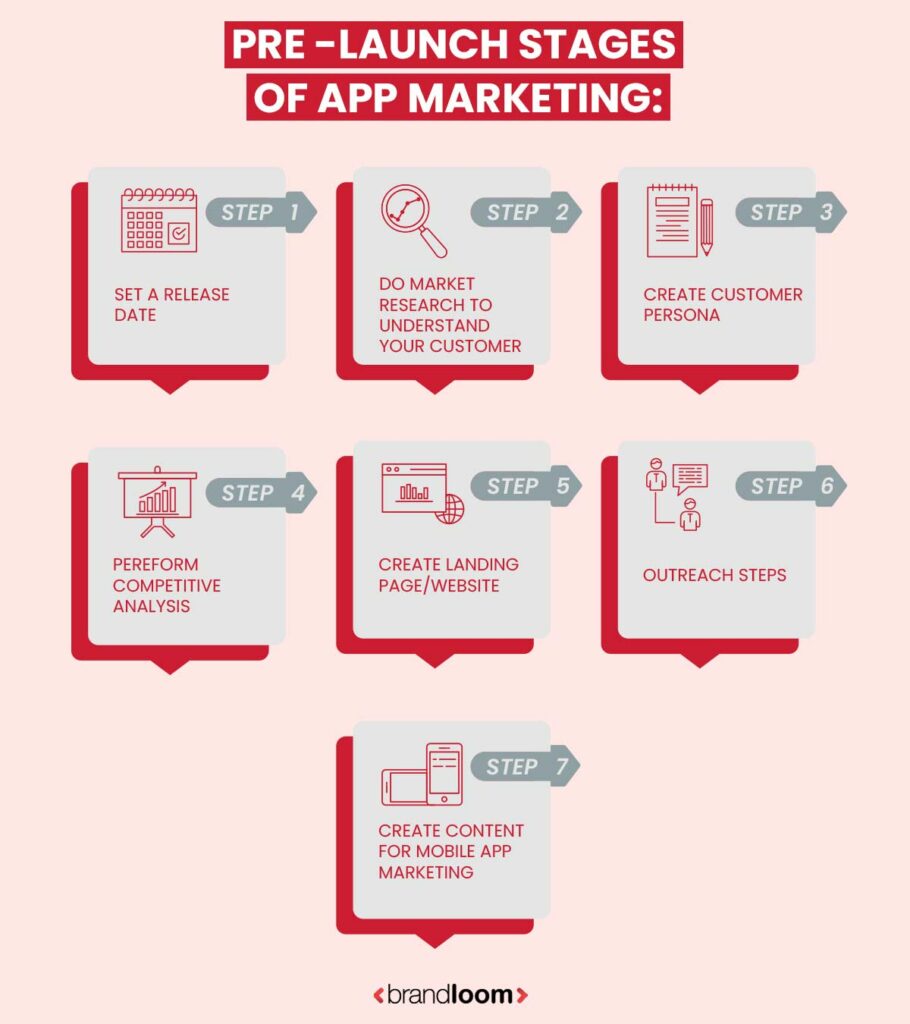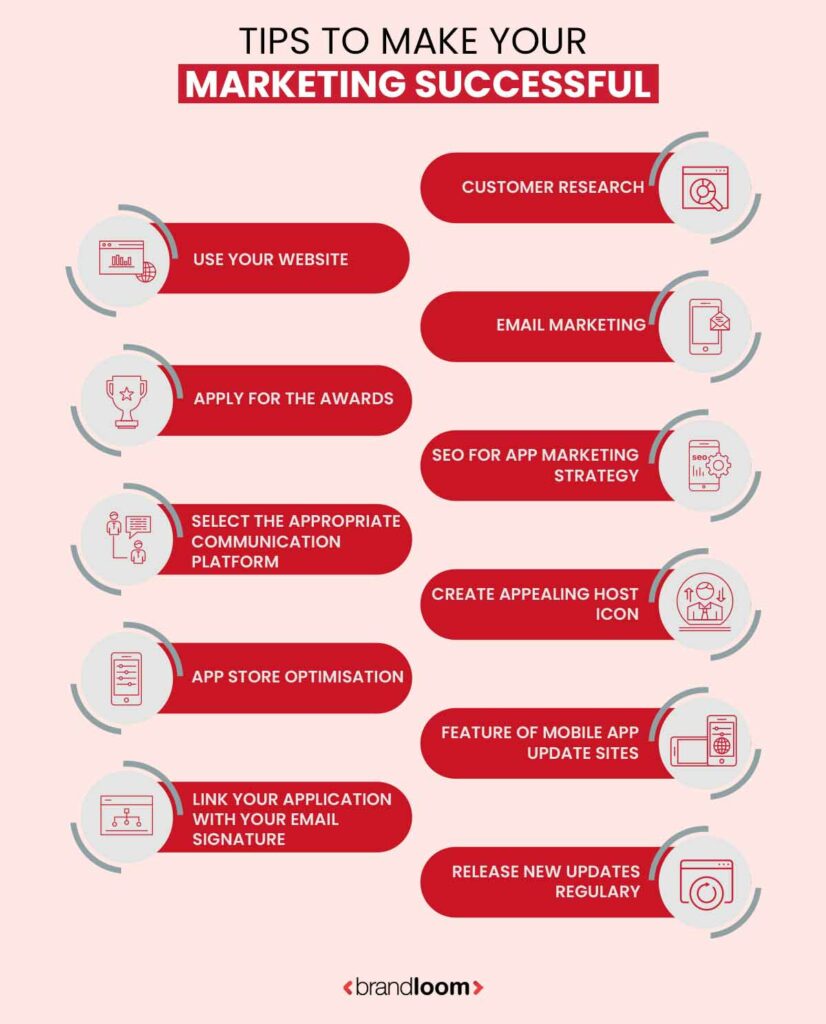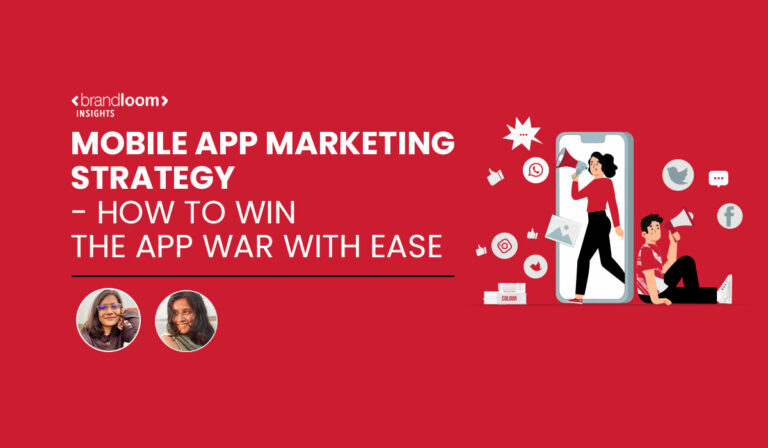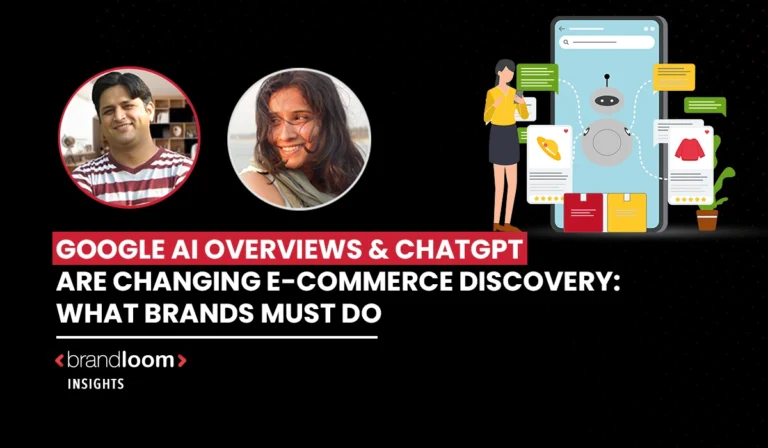On the app stores, countless mobile apps are in every niche, so there is a likelihood that your new app will get lost in the crowd.
It all depends on you to spread the word about your app and make it popular.
However, by following the right mobile app marketing strategy from the beginning and picking winning app marketing strategies, you will be able to get more people to download & use your app.
You must understand how to market your app to improve your overall mobile app marketing strategy.
It requires an understanding of how various methods can be incorporated into a successful mobile app marketing program. It applies to all app advertisers regardless of the specific schedule, budget, and target audience.
You can also hire our digital marketing app consultants to manage your mobile app marketing strategy. BrandLoom is India’s leading marketing agency.
This article outlines key marketing strategies for an app you should know & how to apply them to achieve your most ambitious goals.
What is the need for Mobile App Marketing?
Marketing activity for mobile apps needs to have a wide scope.
Suppose, you have decided to design an app that lets users choose where they wish to go for a vacation and how much it might cost them. The mobile app runs smoothly, and the user interface is engaging, but how will it stand out from all the others?
Here comes app marketing in play!
Most companies and app developers begin marketing their apps in the nascent stages of development.
App marketing has become increasingly important as the competition to provide the best services has increased. Most companies and app developers begin marketing their apps in the nascent stages of development.
It also helps generate hype, and people want to look forward to it. Most companies allow users to pre-register for apps while they are still developing, giving them insight into what potential users want.
Your mobile app marketing does not end there; it begins here.
After generating buzz among potential users, you want them to use, test, and review your app, so you have to consider your marketing strategy while the app is still in the early stages of development.
Mobile App Market research
According to the International Business Times, the App Store receives more than 1,000 applications per day. Competitiveness in all aspects is intense, and it is important to understand your competitors as you develop your overall strategy.
Market research can help you better understand how to use marketing strategies for the apps. To begin the journey of innovation with extensive market research, you should be able to answer the below-written questions at the beginning of the development process:
- Who is your target audience for your app?
- Why are they interested in your app?
- How do your competitors target the same audience right now?
As an app marketer, your job is to provide for your user’s needs and make it easier for them to find / access your app.
The Pre-Launch Stage App Marketing Strategy
The awareness phase of the mobile app marketing strategy starts before launching the App. This stage is designed to create brand awareness and visibility.
Specifically, how will your target users find your mobile app? Before starting the awareness phase, you must have a complete understanding of the brand message and structure of your App.
A brand is built on its value and purpose. Here is a list of steps and strategies you should follow in the pre-launch phase of your marketing plan.

1. Set release date
Compared to Google, Apple has a solid review process that may delay your app release, or you may experience an unexpected setback. Planning gives you enough time to prepare for a tough start to your product and allows you to anticipate potential situations.
Expert Advice: When planning your launch date, consider local events that have the potential to block the launch of your app.
2. Do market research to understand your customers.
One of the common pre-launch mistakes is not doing proper market research.
Before starting any development work, you need to identify the major players in your app category.
No matter how strong your marketing efforts are, your app will only be successful if it helps users or addresses the pain point to become the most effective app solution in the market.
Expert Tip: Discover and research the most influential blog posts, groups, forums, and websites visited by your audience. These channels may help you reach and find the right customers.
3. Create customer persona:
Creating a customer persona is the most important step in this journey. A persona is a fictitious image of your ideal user. User personas have almost everything from demographics, background, mobile preferences, and unique identifiers.
Everything from branding and app content to functionality, features, platform selection, and monetization strategy should be done to suit your targeted customer.
By properly defining your audience and your customers, you will answer key questions that will guide your overall app marketing strategy.
For example:
- What was the main cause of the grief that the audience felt together?
- What mobile operating system do these audiences use? IOS or Android?
- What kind of content do these viewers share online?
- Which tone, voice, and content style best suits your audience?
Are there any visible advertising patterns from the work of these online viewers?
4. Perform competitive analysis
Your app will compete in the marketplace with other Apps targeting your users. List five competitors, their current price, monetization model, App Store level, Consumer Information features(UX), and negative and important updates.
Think of ways that you believe differentiate you from your competitors.
5. Create a website or landing page
Websites or landing pages are the first source of information about your App. It has become customary to create a website or landing page for the introduction of any mobile App.
If you already have a video of your App, you can use it to showcase its features. Based on user analysis, you can reuse the content by posting it in the App Store or forums or using it in paid advertising.
In addition to gaining popularity for your app, a pre-launch website is another great way to drive advanced search engine optimization (SEO) by building your domain authority.
When setting up your website, please send emails to notify your fans and tell them when your mobile app launch is planned and when you have updates and new features.
6. Outreach steps
Attempts to communicate by contacting promoters, publishers, and bloggers to generate backlinks and provide reliable updates are one of the most overlooked parts of marketing a new mobile product.
Make a list of KOL’s related to your field or niche that you are interested in writing and reviewing about your application.
7. Create content for your mobile app
Start writing blogs months before planning the launch. If this is your first time, you already have control over your niche and followers. Present and easily record posts, show app features, and show screenshots and videos. Here are a few of the key benefits of marketing your app content:
- Drive traffic, conversions, and app brand awareness
- Build your app by becoming an expert in your niche
- Build customer trust with content
- Blog content is used for email marketing to engage in consultation or communication.
Once you have covered pre-launch Market research, you must have developed the right approach toward using marketing strategies for the apps.
Launch Stage Mobile App Marketing Strategy: Creative Mobile App Marketing Strategies
The general rule of marketing says one should spend as much time in marketing as they spent creating the product. If you spend two days writing a blog post, then expand your blog post to as many places as possible in the next two days.
The same theory can be applied to your mobile app. Months of development should be translated into months of promotion. The more you promote your app, the faster, easier & smoother the process.
We know that small businesses do not have large budgets to support advertising or advertising activities. Even for those with money, tracking your content can take time and effort.
This in-depth guide will tell you how to market an app & taking your app marketing strategy to a level above.

1 Use your website as a mobile app marketing strategy.
If you already have a fully functional, user-friendly website, your site will be one of the biggest assets in promoting your app. Sometimes, all your customers and anyone interested in your app will visit your website. When they do, everyone needs to know that you have the app.
A small section of your site dedicated to your app could be part of your overall site design. You can also utilize web push notifications to increase the visibility of your app.
Putting your app on your website is one of the best ways to improve the mobile app visibility, which you can use, including your custom blog posts.
If you are looking for more tips, check out our blog.
2. Email Marketing: an important step in mobile app marketing strategy
Your new app should be engraved in all aspects of your marketing efforts, including all your emails. As a business, you send out many emails and do not include your application in every case where the opportunity is missed.
Any email sent from your technical support, your newsletter, or your payment confirmation email must contain a one-line statement for your app. Enter details such as what can be accessed from the app and the redirect link to the download page. You can refer to our separate blog for email marketing here.
3. Create a teaser video
Videos are an easy way to showcase everything your efficient and well-designed app offers.
Once you create your demo video, use your social media channels and other forums to promote your app.
4. Apply for the awards
You can get a lot of press releases, exposures, reviews, and multiple downloads by participating in the App Awards. Although your chances of winning largely depend on your app focus, you may enjoy some sparkle if you can fix things for the first time.
Here are some of the most popular app reward sites:
- Appy Awards
- Best App ever Award
- App circus competition
- Apple Design Award
- Appster’s Awards
- Ericsson App Awards
- Webby Award
- Best Award for Mobile App
- OZApp
5. SEO for mobile app marketing strategy
Yes, I’m talking about SEO, not ASO … How does your app’s URL appear in search results when users have important related questions; For example, when viewing music apps, you want your app to appear in the first 5 entries before the user presses enter.
You must identify the “most targeted” keywords and the most relevant ones you want to rank for. Also, analyze the keywords your app currently lists For and create specific quality links to improve standards.
We know how difficult it could be to do SEO, but you should focus on your app’s trial check. Let India’s leading ROI-generating marketing firm deal with it, hire BrandLoom.
6. Select the appropriate communication platform
Increase your visibility on social media and community groups, especially LinkedIn and Facebook, so you can better know the founders and app developers.
Ask for their opinion on your app and gift them a free promo code to try. Talk about current features, bug fixes, & future updates, and let us know your thoughts. You can establish a good relationship with them, opening the door to promoting each other’s apps without spending a single penny.
7. Create an appealing host app icon
With around 1.6 million apps in Google Play Store & 1.5 million apps in the App Store, any category you choose to install your app will cause a lot of clamors. Because of that, most people choose to be interested in apps only when the app logo is appealing to them.
To keep your app logo unique, you need it to be well-designed and must:
- Have a unique bright background
- Have a limited color palette – 2 is enough to make a difference
- Avoid using images – it gets messy!
- Avoid too much text
- Be creative!
It’s also safe to look at your app logo in different color wallpapers.
8. App Store Optimization (ASO)
At its core, App Store (ASO) optimization aims to improve Google Play and the App Store’s search engine (SEO). Like search engine optimization, the App Store setting focuses on your description’s keyword relevance, search alignment, and keyword density.
The app description is a key element of your mobile app marketing strategy, as nearly half of US iPhone users find apps via search.
9. Featuring on mobile app update sites might help with mobile app marketing strategy.
Getting into the app reviewing site means you need to pitch them. This means you must verify the website that your app is decent enough to be reviewed by them and have it featured on their site. Many of these application review sites look for the following:
- Beautiful high, quality icon
- Original and unique content, tools, themes, and art
- Fixed applications with no errors, crashes, overload times, or poorly compiled content
When you opt for a feature, you probably need support for the app. It is usually done through a form with the following items:
- Linking to your app in the App Store
- The summary section that describes your application and what makes your app stand out
- Screenshots of your app logo, title screen & content in the app
- YouTube or Vimeo Links to your app videos.
- The Promo code is the key that allows anyone to download the app for free. You can handle this if your app is free.
- Getting media and updates about your app is a subtle way to monetize another site’s traffic.
10. Link your application with your email signature
It can take weeks or months for all your current customers to know that you have launched a mobile app. But the same customers may receive emails from you every week or even every day.
Add links to your app downloads or your app feature page with your email signature, which is a very easy way to get your app downloaded and increase visibility through your usual email.
Simple things can be very effective over time.
11. Release new updates regularly to improve the mobile app marketing strategy
Your customers need to know that you are improving the app. Missing updates apps are cornered. Customers will feel cheated if you do not do everything you can to make them have better experiences.
This is especially in case you have not mentioned a few issues that annoyed customers in the review sections. Keep the content of your program up to date and inform your customers that you are always planning something extra to enjoy.
And to save yourself from all the marketing efforts, you can hire BrandLoom to take care of your app marketing.
Post Launch Mobile App Marketing Strategy: Bulletproof mobile app engagement marketing strategy
In today’s market, app marketers face a number of difficulties, including low engagement and churn.
The jaw-dropping statistics draw a picture:
- Within the first month of downloading an app, one in two is uninstalled. The top reason for uninstalling a mobile app is “not being used” (39.9%).
- Among users who engage with an app even once a week, 90% remain loyal to it.
In the App Store & play store, there are 1.96 million apps and 2.89 million apps are available, giving users nearly unlimited choices. If you fail to meet your users’ expectations, you’ll end up seeing the majority of them abandoning your app (= low retention rates).
Your app can be improved by using this data to give your audience a better experience, leading to a higher retention rate.
App engagement strategies must include email, push notifications, in-app notifications, and social media remarketing. How do you choose which channels for which purposes, you ask? It’s important to consider the stage of the user and the type of communication that’s being sent.
Let’s break it down:
1. Push notifications to keep your users informed
Push notifications can be one of the effective ways to engage app users, but there are also many ways to cause them to uninstall your app if misused. So which is the right way to use push notifications for our own benefit?
Best practices and benchmarks are applicable in several fields, but what matters most is: Does my audience receive something valuable out of it?
User experience can be improved through personalization and relevance by offering real value in push notifications.
When it comes to your engagement tactics, keep a check on your push notification statistics, which can help you determine what works – and what doesn’t – from a marketing perspective.
2. In-app messages To Connect With The Users.
Research has shown that brands using customized in-app messages experience 61% to 74% user retention rates within 28 days of receiving them.
In order to keep your users engaged, you must align your app experience with their needs and preferences. A brand launching mostly generic campaigns sees its retention rate cap out at 49% after 28 days.
While in-app notifications are not intended to communicate immediate calls to action, they are nonetheless important notifications to receive. They can warn about app issues, payment failures, or updates.
Using custom messages that include real-time updates & links to personalized content, you can ensure maximum relevance by segmenting your audience by location, preferences, usage, or history.
3. Use Email / SMS Marketing For Your App Promotion
Because onboarding is a continuous process, sending out an occasional email can help you retain users. Retention comes down to serving customers well and keeping your app at the top of their minds.
A user that was once active and has since drifted away might be contacted via email. The least intrusive way of saying, “we have missed you. Let us show you what you have missed.”
Besides encouraging retention, email is also an effective way to encourage new purchases within the app. For example, an enticing offer can be sent out to a customer that hasn’t purchased for 3 months.
Or, in the case of content/product sharing applications, a user who was active for 7 days straight but didn’t open the application for 3 days can get a link to a trending product in a category they’re interested in. Right audience segmentation could mean the difference between an idle user and a re-engaged and therefore engaged user.
4. Analysis and Personalization is the key to a customer’s heart.
You can maximize your conversion rates by analyzing the data you’ve collected, identifying what your customers want, and personalizing your campaigns. By targeting different audiences with customized campaigns, you can be seen as a brand that cares—boosting loyalty and conversion rates at the same time.
5. When All Else Fails, Retarget your audience.
No matter how carefully crafted a marketing campaign is, sometimes it doesn’t work. Retargeting can help you get your desired results.
By retargeting -customers you lost on other platforms, you can win them back with smart deep links and personalized ads – and give them a brand-new experience they’ll never forget.
6. Offer Loyalty Incentives as a mobile app marketing strategy.
Despite the amount of effort we put into acquiring new customers and bringing back those we’ve lost, long-term customers often get ignored. In order to increase your company’s revenue, you must keep loyal customers happy. They tend to spend more than their newer counterparts.
For companies like Sephora, Expedia, and Ben & Jerry’s, loyalty incentive programs such as membership programs, reward systems, and value-driven clubs have proven to be effective.
Now that you have a strong hold on your customer base and doing everything right comes one of the most important parts of strategy structure.
Mobile app monetization strategy for your app
It is challenging to choose the right monetization strategy for mobile apps because there are so many options available. How do you monetize an app? And Which of the app monetization options is right and appropriate for your business? Should you charge for downloads or free downloads? If not, how do you make money from free apps? How do you generate steady revenue without compromising the user experience?
Let’s take a concise look at the best app monetization strategies one can follow to see how we can make our apps earn money.
1. In-app Advertising Strategy
The use of in-app advertising is one of the effective methods of monetization. By the end of 2023, the app-install ad revenue in the US is predicted to reach $146 billion. This is a fast-growing advertising outlet that pays app developers to serve ads within their mobile apps. Click-through rates (CTRs) for mobile app advertisements are 152% higher than for standard banner ads.
Pros
A user’s experience can be improved with in-app advertising formats that do not feel intrusive or pushy.
Furthermore, the strategy offers advertisers advanced targeting options, implying that they are willing to pay to reach the best audiences.
Free apps reach a larger audience base.
Cons
Poorly implemented ads may negatively impact an app’s usability because your users may not be fans of any kind of ads.
Due to concerns relating to tracking, data usage, and brand safety, not all brands are inclined towards the merits of this strategy model.
Example: Instagram
Advertising on Instagram has been highly targeted, and users have enjoyed the ads. In 2013, when Instagram introduced ads, many Instagrammers were concerned about intrusive ads affecting their experience.
According to estimates, Instagram will generate $20.3 billion in global mobile advertising revenue by 2023, compared to a median of 0.07% for display ads.
2. Paid Apps Strategy (or Pay-to-Download Apps)
Another app monetization strategy that has been around for a long time is pay-to-download. It is pretty simple: you set a price & collect money upfront after the app store takes a cut. The model was popular in 2008, but with so many free apps on the market, charging an upfront price may be difficult to sustain.
In order to find out what the standard prices for your app category are, you would prefer to conduct a competitor analysis. In order to maximize revenue, you will need to optimize the price by analyzing app download analytics, which will give you insights into how much your target audience is willing to spend.
It may be difficult for paid apps to grow, but they can still be successful if they show that they offer value to their users.
Pros
Users tend to engage with and remain loyal to paid apps more often.
The likelihood of users using something they’ve paid for increases.
Cons
The number of paid apps downloaded over 100 times is 20%, and the number of paid apps downloaded over 10,000 times is 0.2%.
3. Freemium Strategy Model (Free Premium)
An alternative method of monetizing mobile apps is through freemium strategies. An approach that combines free and premium features involve offering two versions of an app — one version offers basic functionality for free, while the premium version includes additional features.
The concept behind the model is simple. Users download the app, find it immensely valuable, and then upgrade to take advantage of the additional features.
Pros
Users are typically loyal to the free version since it allows them to try the product before they buy it.
The system is highly flexible & can be used in a variety of industries.
Cons
Ensure that your app has free features so that churn isn’t too high.
The model relies heavily on time and options. If your users want to upgrade to the premium version, you have to give them sufficient time to decide.
4. In-app Purchases Strategy
To earn money with your application while keeping it free to download, consider the in-app purchase strategy.
A monetization strategy model like this is particularly useful in the world of gaming (power-ups, extra lives, or in-game currency) but can be found in other app categories as well (e.g., dating apps with more visible profiles and enhanced options).
A rising number of people are using the model. In-app purchases are on the rise, and the majority of users prefer to spend time playing a free game before they become addicted to it & start paying.
Pros
Profits ratio higher in this model without a lot of risks.
For eCommerce, this is the best monetization model.
Cons
The App Store you choose will charge you a commission for selling virtual goods.
Transparency is essential when it comes to in-app purchases in apps.
5. Subscription mobile app marketing monetization strategy
It is relatively new to the mobile world for a business model to be based on subscriptions. This model is very similar to a freemium model, which allows users to test the app before they download it. Apps with high engagement with users will find the model generates a lot of profits.
Example: You’ll find streaming apps like Netflix, Spotify, and Apple Music in this category. In addition, you’ll find productivity apps like Evernote in this category.
The model has two options: non-renewing subscriptions and automatically renewing subscriptions.
Subscribers pay only once for a non-renewing subscription, and their subscription will last for the subscription period (typically one, three, or six months). After expiration, the user has the choice to buy another subscription.
A subscription that gets automatic renewal at the end of subscription period: Users in this situation must pay for their subscription and then gets renewal itself at the end of the period. Typically, the renewal period is a week, a month, six months, or a year.
Consequently, to succeed long-term, one must market their app consistently. And should follow the mobile app marketing strategies we talked about above. If you cannot follow these strategies, you can also hire app marketing experts like BrandLoom. Our team of experts at brandloom can help you with every aspect of app marketing.
Conclusion
You can rank in the top Play Store & Apple Store positions with proper marketing strategies.
Your app won’t receive much attention if you don’t employ marketing strategies.
Doing so would reduce the possibility of increasing application downloads and gaining new users.
You must invest in app marketing to get the most out of your app development effort.
Consequently, to succeed long-term, you must market your app consistently. Follow the mobile app marketing strategies we talked about above. If you cannot follow these strategies, you can hire an app marketing company like BrandLoom. They will help you with every aspect of app marketing.
One doesn’t have to put a lot of money into promoting your mobile & Smartphone apps that only rely on app development techniques like Apple search ads will not succeed in the long run. You need to develop a mobile app marketing strategy that gets organic downloads without paying for ads.
Frequently Asked Questions:
After launching your app, the first and most important thing is to ensure the optimization of listing on either the Apple App Store or Google Play Store. There are millions of applications, so Apple and Google sort their apps based on many factors, such as popularity, features, reviews, and more.
The objective of App Store Optimization (ASO) is to improve an app’s visibility in app stores. App stores rank apps based on a variety of factors. You can rank higher and drive more downloads by using optimized keywords, useful images, and localized descriptions.
ASO refers to search and ranking algorithms on an app store. There are some ways in which SEO and ASO overlap – which may be useful when starting to improve rankings on the App store.
An ASO essentially functions as a closed-site search engine. An efficient way to increase the reach of your app & to communicate the usability of your app to both the current and potential users, just like with SEO. It relies on indexation, discoverable content, and manipulating the App store’s ranking algorithms.
For this reason, working on the methodologies that will fully optimize your app for the App Stores is critical to increasing your app’s visibility.
And to save yourself from all the ASO efforts, you can hire BrandLoom to take care of your app marketing.
App store optimization involves enhancing the app’s search results, so it ranks higher in an app store’s search results.
Consequently, a higher ranking in the app store’s search results means that your app is more visible to potential customers. Generally, that increased visibility leads to more traffic to your app’s page in the app store.
And to save yourself from all the marketing efforts, you can hire BrandLoom to take care of your app marketing.
LinkedIn, Pinterest, Facebook, Instagram, Twitter, and other social media platforms allow you to expand your web presence and connect directly with your target audience.
If your app targets certain age groups, identify and focus on the most popular social media platforms for these people.
Be sure to consider the following:
– Have you clarified to the audience that you offer app services from the first look at your social profile?
– Is the purpose of the app clear?
– Is there a link to download the app?
– Post company updates and features that will delight fans with the launch.
– Create a dedicated hashtag & use it in posts when appropriate. Not only posting and sharing promotional material but also sharing the fun and engagement associated with your app to build a community behind it.
You can always save yourself from marketing drama and hire a marketing agency like Brandloom to take care of your app launching, marketing strategy, and execution.
There are several steps one can go about performing mobile app marketing, and the following section discusses the most effective steps that have proven to work in the industry:
Step 1: Pre-launch marketing
As a marketer, you must raise awareness of the app or generate the appropriate buzz during the app’s development.
Step 2: Post-launch marketing
When the application has been developed completely and is ready to be distributed to customers, this phase involves using strategies that will encourage customers to download the application.
Step 3: Customer engagement and retention
With this step in mobile app marketing campaigns, the goal is not to have customers use the app once and then uninstall it. Instead, the goal is to have them engage with it repeatedly.
Step 4: Application monetization
Application developers should offer exclusive services and subscriptions to users, adding attractive in-app purchases to enhance the user experience. They will be able to drive finances more easily with a rich user experience.
And to save yourself from all the marketing efforts, you can hire BrandLoom to take care of your app marketing.
The main difference between ASO and SEO is that SEO is primarily concerned with ranking websites and content on a search engine, while ASO is concerned with ranking apps on app stores.
Both of these methods provide very different results.
Respond humbly to all your reviewers & reviews.
If your customers are taking out time to write reviews, you should take the time to respond to them, no matter how long it takes.
Many companies make the mistake of sending the same message to all their customers.
This will not only alienate customers but will also significantly reduce your rating for customers who feel that their concerns are being ignored.
No matter what your customers say, please write down the steps to address their concerns and let them know that you are trying to solve the problem. Respond to all reviews, good and bad.
Meetings, events, and conferences are great places to hire new mobile app users. Bring a stack of business cards with links to download your app and give them to everyone you talk to.
Some meetups may have hundreds of people, but a conference may have thousands. Have a brief introductory conversation with the people at the party and give them a business card.
Suggest they check out the app and contact you for feedback. This is a great way to bring more new users to the app and get feedback to improve.
And to save yourself from all the marketing efforts, you can hire BrandLoom to take care of your app marketing.





I went through your article which was on marketing and promoting mobile apps. When it comes to marketing and promoting mobile apps, there are several effective strategies you can employ to increase visibility, drive downloads, and engage users. Here are some of the best strategies:
1.App Store Optimization (ASO)’
2.Engaging App Icon and Screenshots
3.Content Marketing
4.Social Media Marketing
5.Influencer Marketing
6.App Review Websites and Blogs
7.Paid Advertising
8.App Analytics and Optimization
According to me these are some important points which you must have in your article. Readers, if you want to do SEO on your website, you can visit a digital marketing agency like Alakmalak technologies. They are experts in this field.